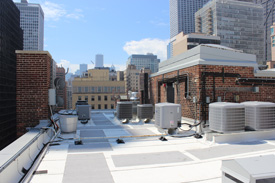Single Ply Roofing
Single-ply roofing membranes have grown in popularity in recent years due to the membrane flexibility, ease of installation, competitive price, and multiple product offers such as TPO, PVC, and EPDM membranes.
In addition, with the emphasis over the last several years on environmentally responsible products and procedures, low slope single-ply roofing is an increasingly popular option.
Single ply roofing is composed of a single layered roof membrane that is made of reinforced thermoplastic or thermo set materials in the rubber and plastic families.
The membranes are known for their long-term weathering ability, and perform well even when subjected to fluctuations in different climate ranges.
 Ethylene Propylene Diene Monomer (EPDM)
Ethylene Propylene Diene Monomer (EPDM)
EPDM, the most popular low slope single-ply roofing material for both new and re-roofing applications, is a synthetic rubber. Initially developed for the automotive industry, it’s able to recapture its shape like a rubber band. In addition, it’s resistant to hail, ozone, ultraviolet rays and thermal shock. In fact, studies have shown that roofs constructed of EPDM remained unchanged in their strength and tear resistance – and in some instances, they improved.
TPO Roofing Systems
This low slope single-ply roofing system is a hybrid of polypropylene (plastic) and ethylene-propylene (rubber) to enhance flexibility, reliability and cost-effectiveness. Reinforced with a polyester fabric and made with ultraviolet-resistant thermoplastic polyolefin, these low slope single-ply roofing systems come in several thicknesses.
PVC Roofing Systems
Using an ultraviolet-resistant polyvinyl chloride, this low slope single-ply roofing system is pliable, durable and water-resistant, able to take on the most inclement weather, chemicals and industrial pollutants.
Advantages
- Durability: Low slope single-ply roofing systems have come a long way in their ability to resist water and withstand most climate conditions, including the hot summers and cold winters of the Windy City.
- Ease of maintenance: As any well-designed roof should, a low-slope single-ply roof usually is relatively easy to clean, inspect and repair.
- Cost savings: Because of fewer steps to apply and reasonable maintenance costs throughout its life, the low slope single-ply roofing system is a cost-effective system.
- Sustainability: Low slope single-ply roofing solutions can deliver reflectivity and emissivity with additional coating. Some low slope single-ply roofing systems come with a zero ozone depletion blowing agent formula. They reportedly have a higher recycling potential and lower carbon emissions than other roofing types. Some low slope single-ply roofing systems qualify for LEED credits.
- Longevity: A well-designed and installed low slope single-ply roofing solution can last up to 30 years, based on the membrane thickness used, as well as a comprehensive maintenance program.
